Abstract
The heterogeneity of the decay of the fluorescence of transparinaric acid in single-component lipid bilayers at temperatures above their gel/liquid crystalline phase transition is shown to be due to the presence of regions of higher local density and higher acyl chain order than the predominant fluid regions. This conclusion is based on selective excitation behavior and the observation of time-resolved fluorescence anisotropies that increase at long times. The fractional amplitude of the long lifetime component of the fluorescence shows a temperature variation that conforms to conventional descriptions of critical behavior. The critical exponent extracted from this variation is 1.1, close to the value of 1.0 that describes ultrasonic data. We therefore conclude that liquid crystalline lipid bilayers exhibit critical behavior with significant density and order fluctuations. This behavior must be taken into account in the interpretation of fluorescence and other spectroscopic measurements of the properties of bilayers.
Full text
PDF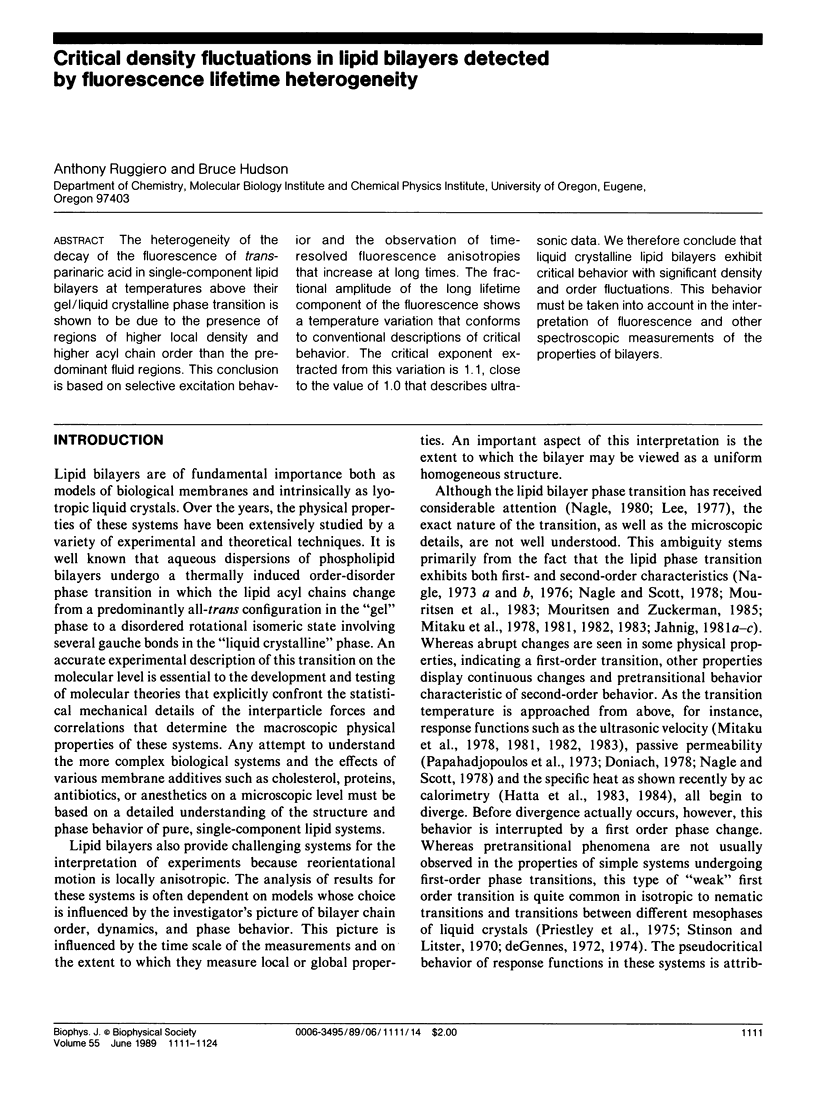

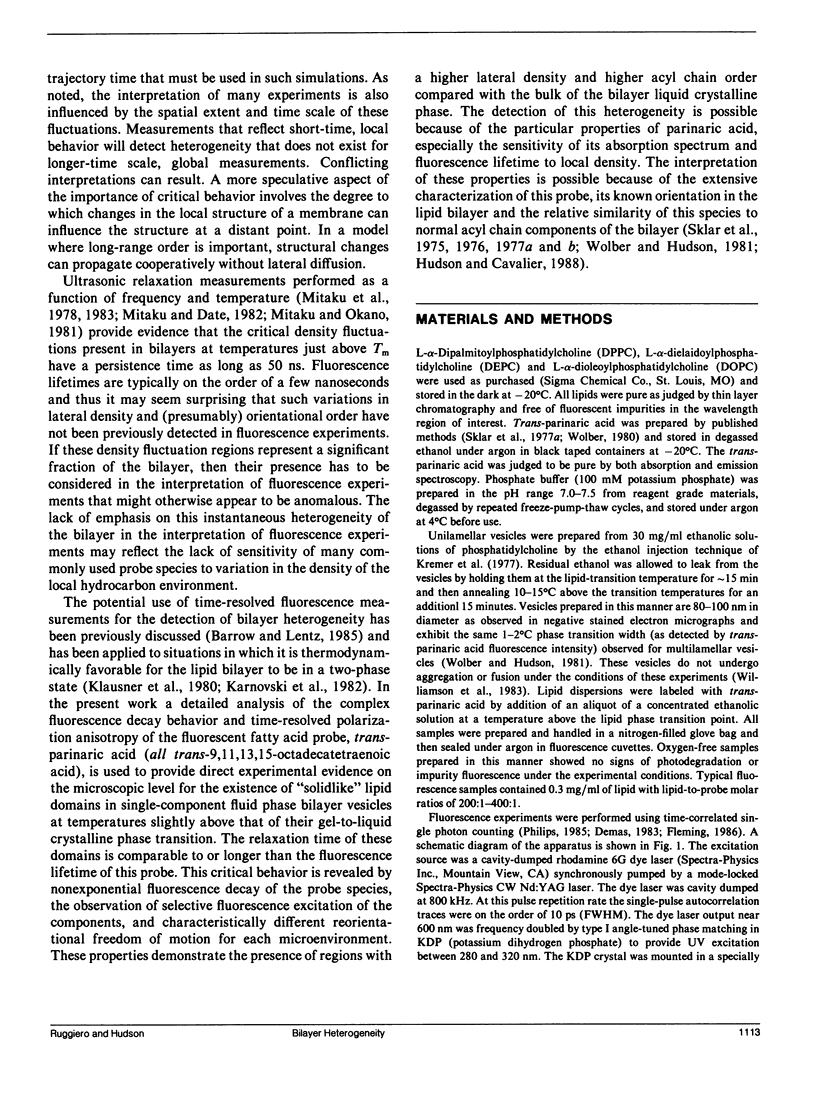
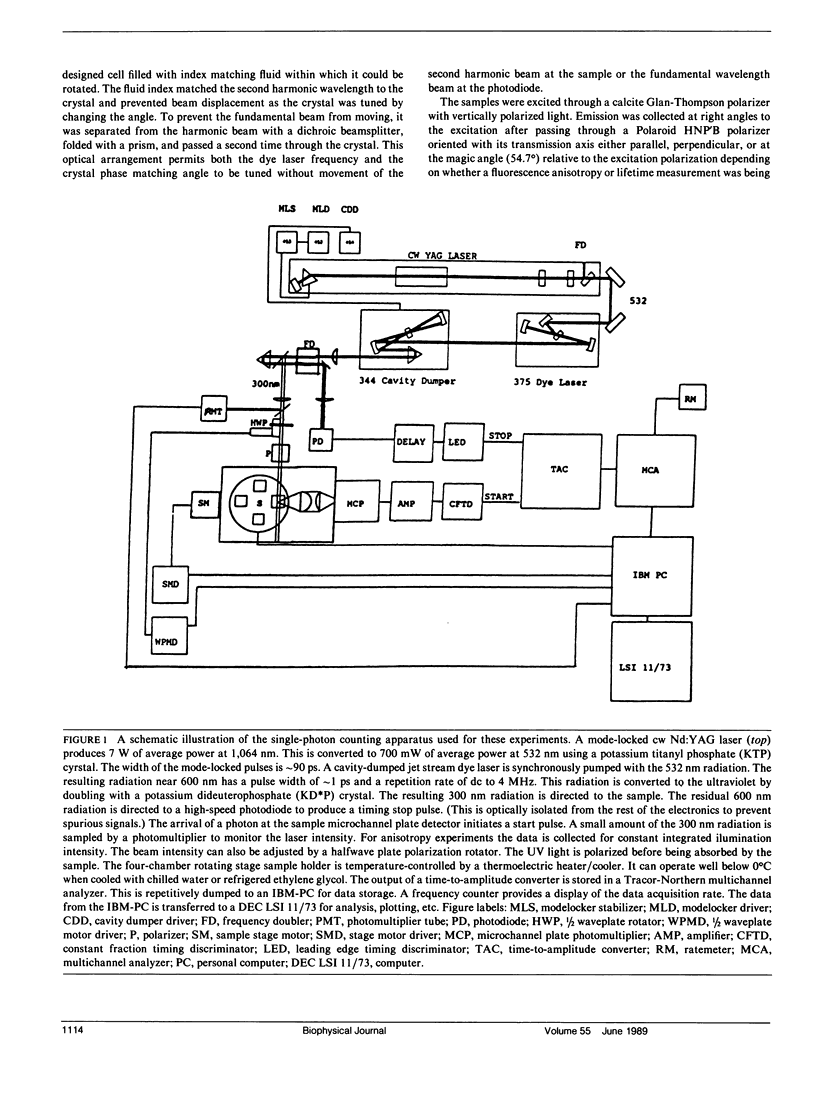
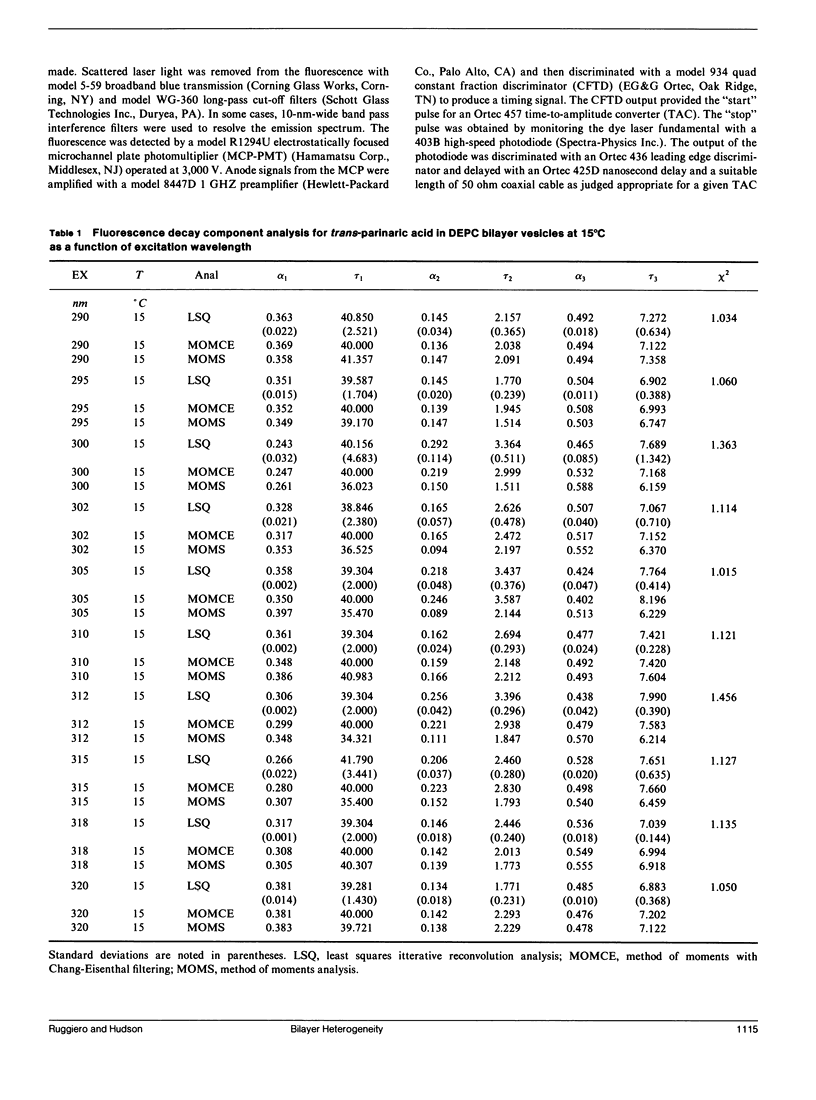
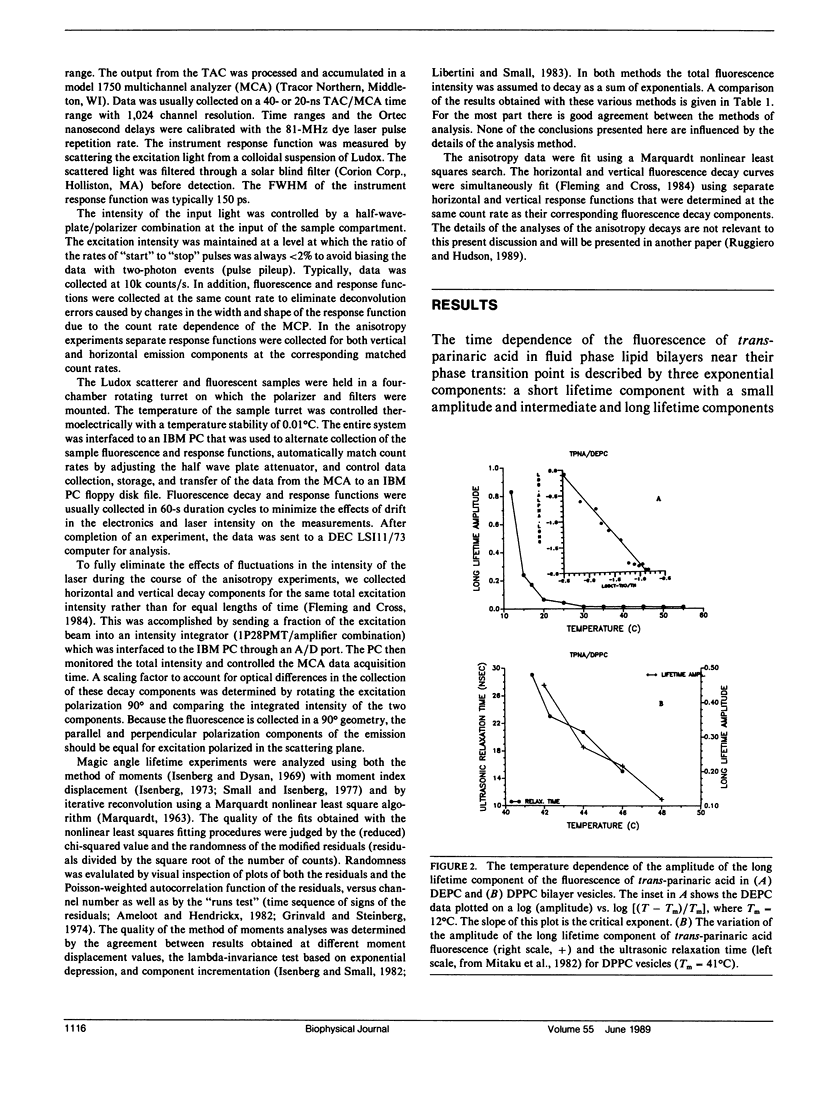
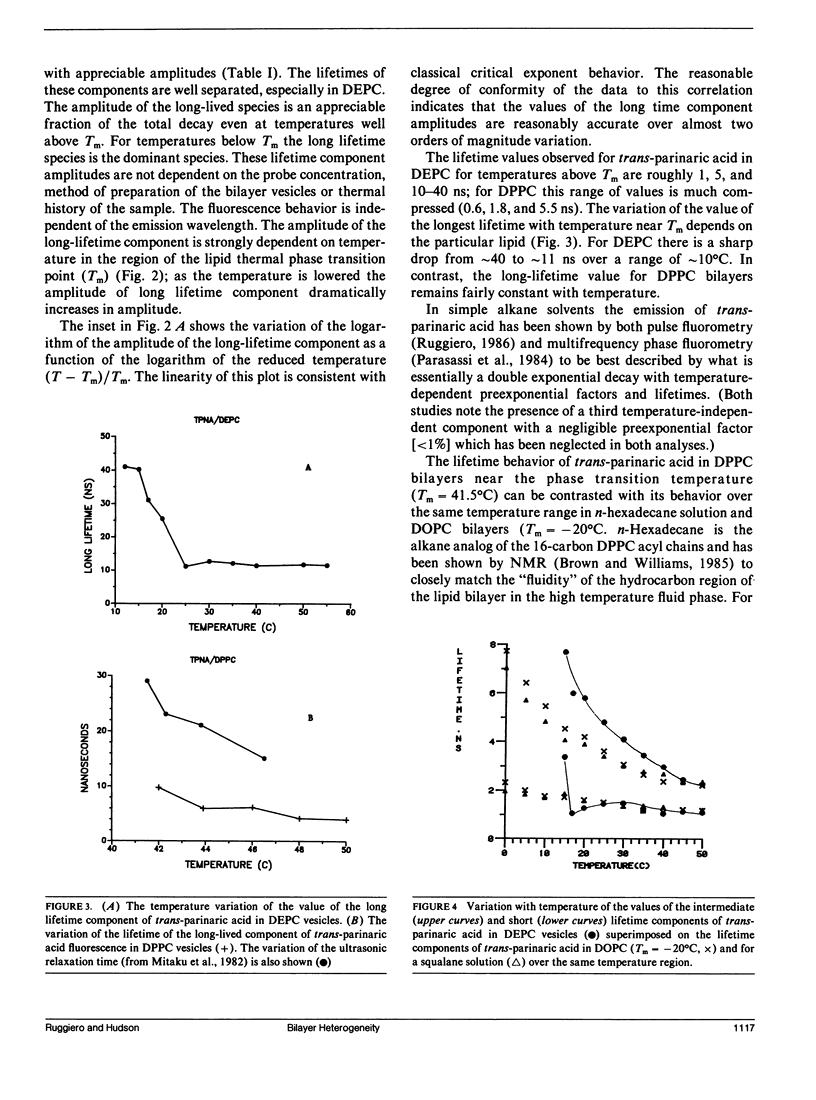
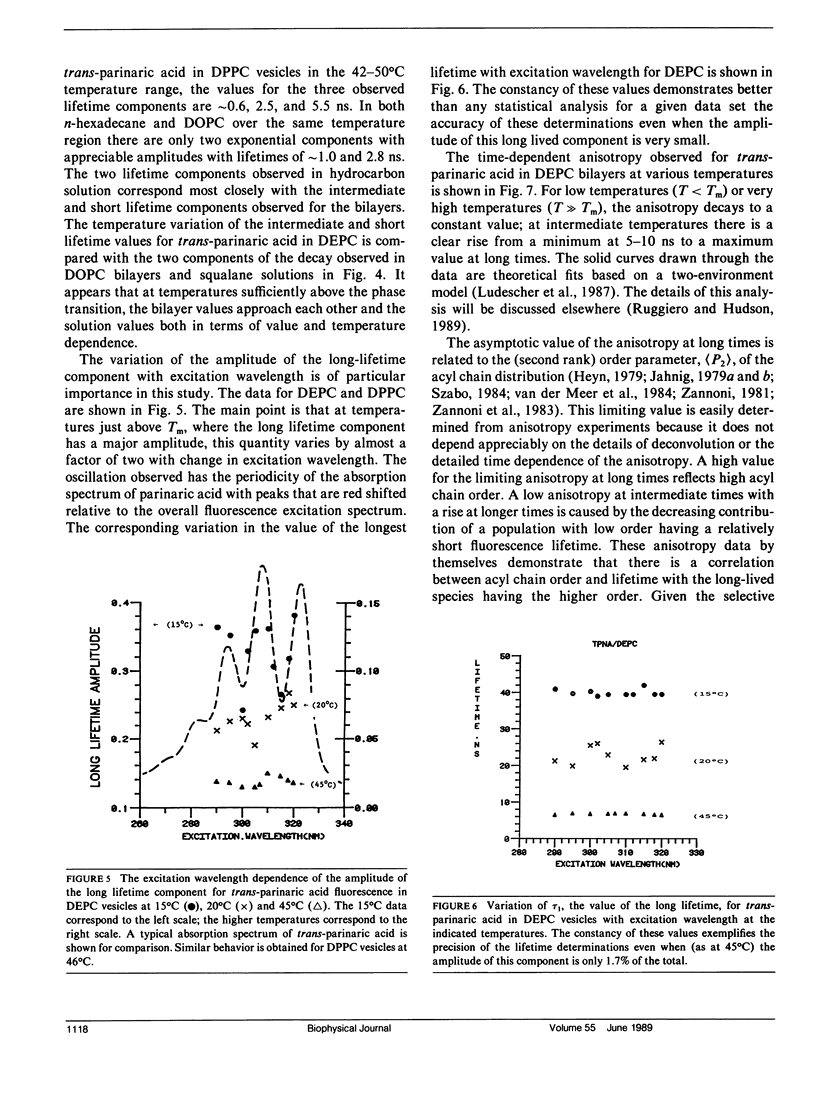
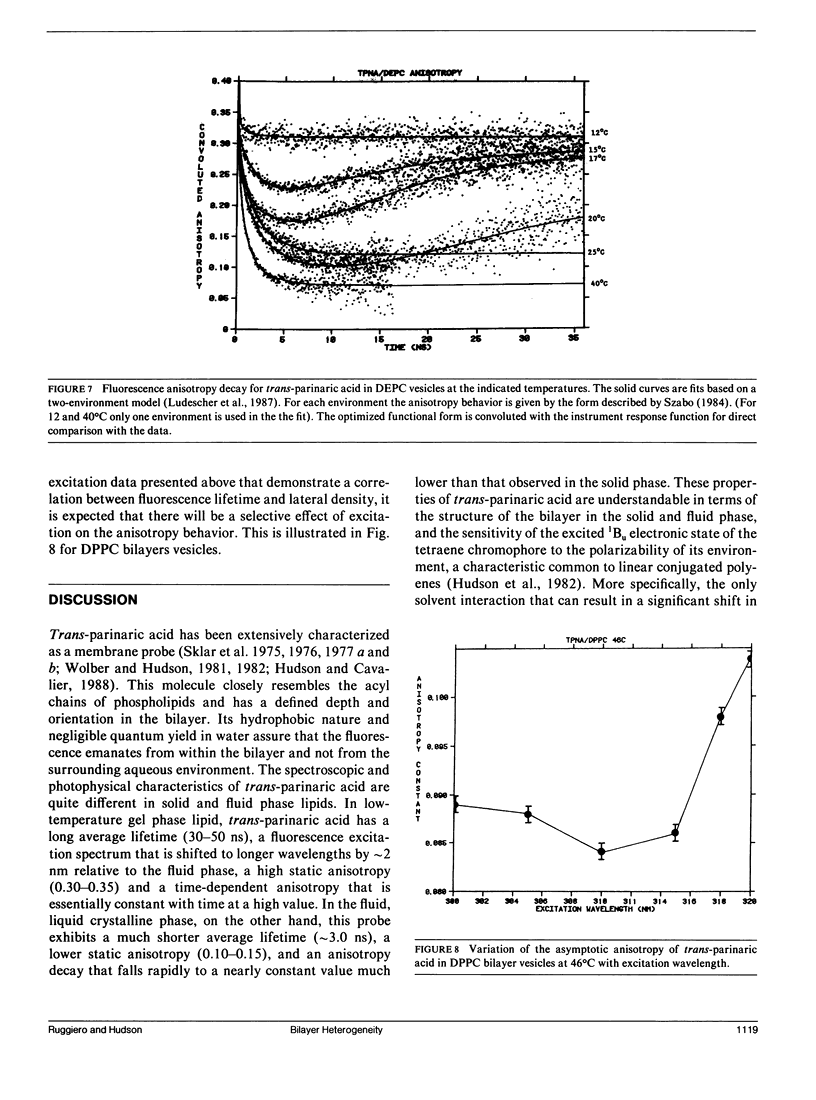
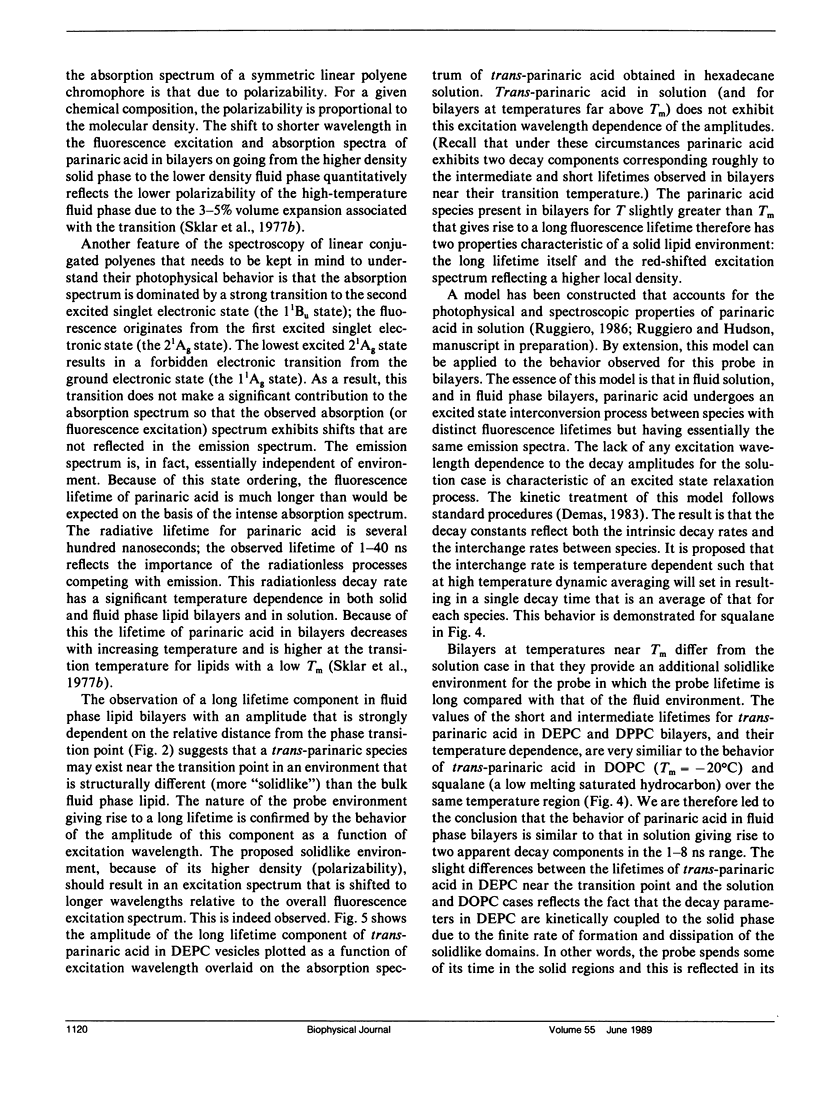
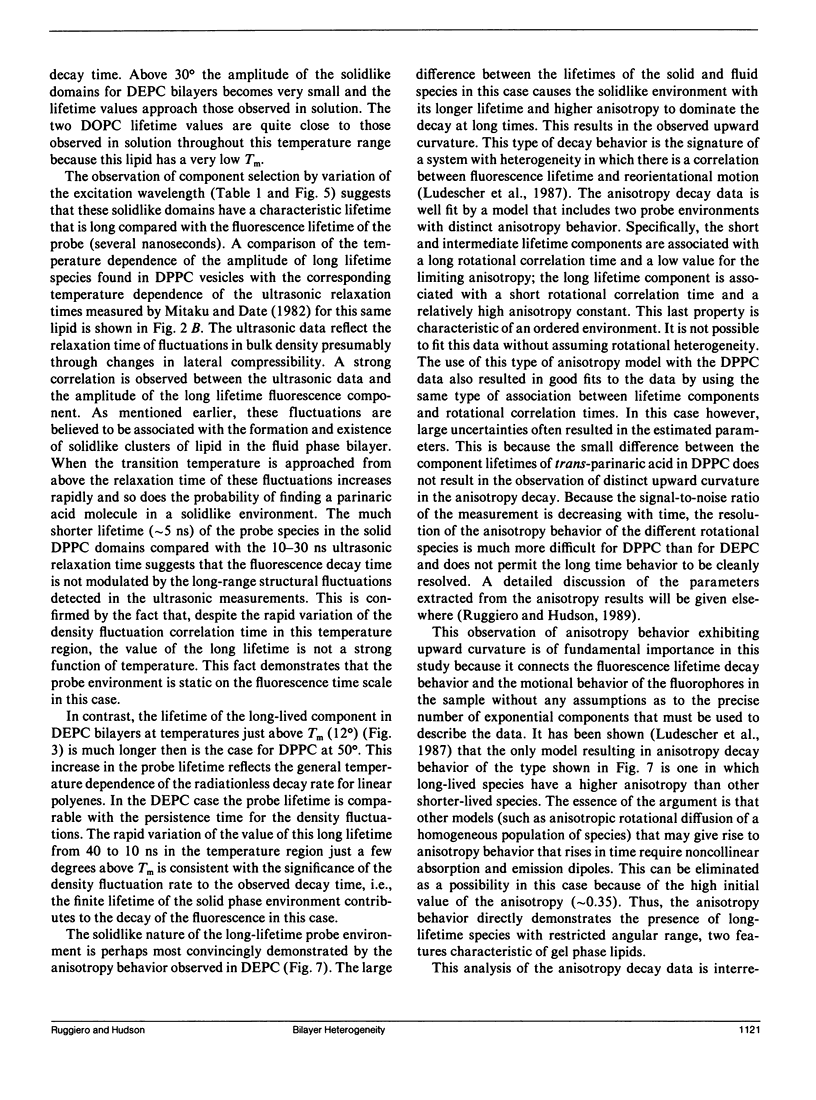

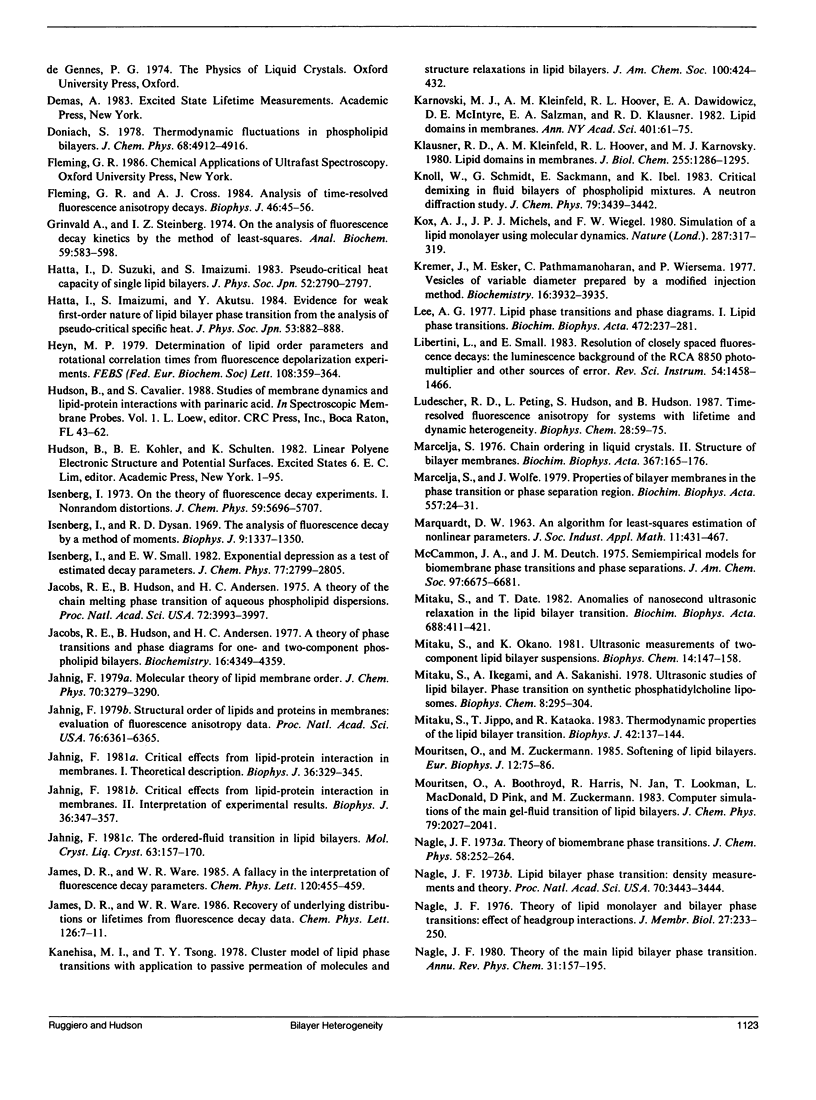
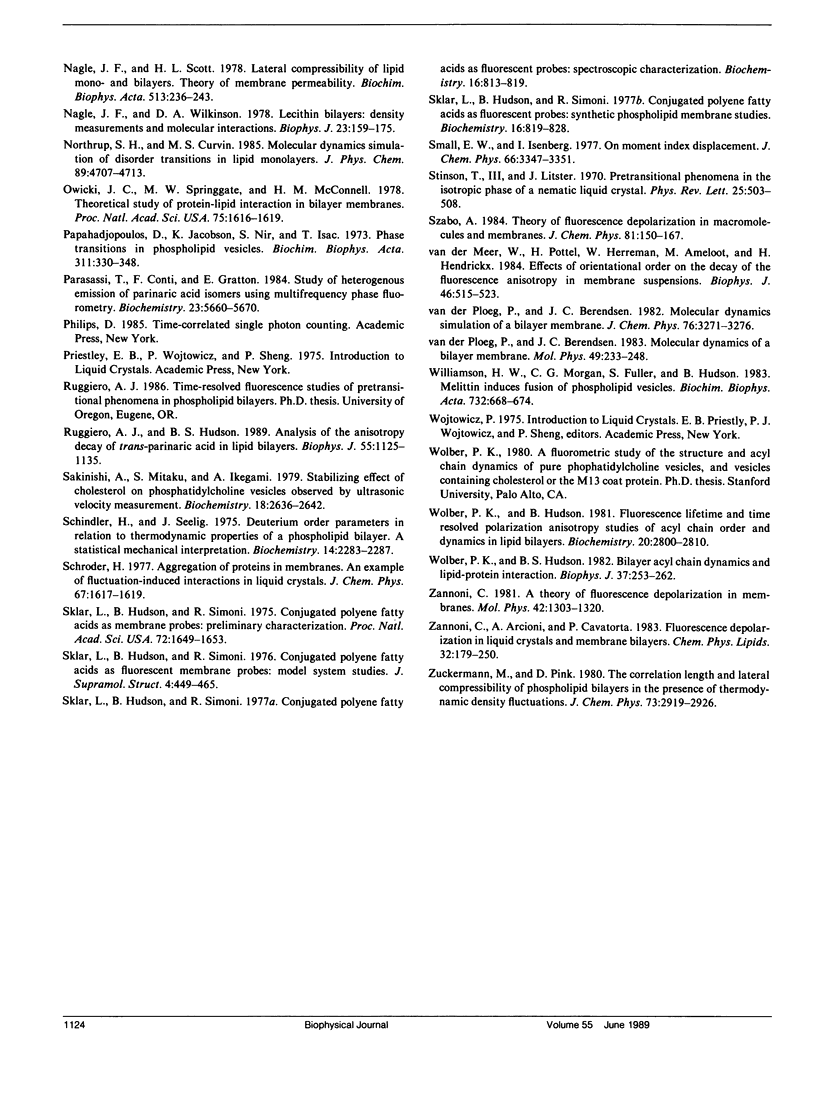
Selected References
These references are in PubMed. This may not be the complete list of references from this article.
- Barrow D. A., Lentz B. R. Membrane structural domains. Resolution limits using diphenylhexatriene fluorescence decay. Biophys J. 1985 Aug;48(2):221–234. doi: 10.1016/S0006-3495(85)83775-9. [DOI] [PMC free article] [PubMed] [Google Scholar]
- Berde C. B., Andersen H. C., Hudson B. S. A theory of the effects of head-group structure and chain unsaturation on the chain melting transition of phospholipid dispersions. Biochemistry. 1980 Sep 2;19(18):4279–4293. doi: 10.1021/bi00559a021. [DOI] [PubMed] [Google Scholar]
- Brown M. F., Williams G. D. Membrane NMR: a dynamic research area. J Biochem Biophys Methods. 1985 Aug;11(2-3):71–81. doi: 10.1016/0165-022x(85)90043-0. [DOI] [PubMed] [Google Scholar]
- Cross A. J., Fleming G. R. Analysis of time-resolved fluorescence anisotropy decays. Biophys J. 1984 Jul;46(1):45–56. doi: 10.1016/S0006-3495(84)83997-1. [DOI] [PMC free article] [PubMed] [Google Scholar]
- Grinvald A., Steinberg I. Z. On the analysis of fluorescence decay kinetics by the method of least-squares. Anal Biochem. 1974 Jun;59(2):583–598. doi: 10.1016/0003-2697(74)90312-1. [DOI] [PubMed] [Google Scholar]
- Heyn M. P. Determination of lipid order parameters and rotational correlation times from fluorescence depolarization experiments. FEBS Lett. 1979 Dec 15;108(2):359–364. doi: 10.1016/0014-5793(79)80564-5. [DOI] [PubMed] [Google Scholar]
- Isenberg I., Dyson R. D. The analysis of fluorescence decay by a method of moments. Biophys J. 1969 Nov;9(11):1337–1350. doi: 10.1016/S0006-3495(69)86456-8. [DOI] [PMC free article] [PubMed] [Google Scholar]
- Jacobs R. E., Hudson B. S., Andersen H. C. A theory of phase transitions and phase diagrams for one- and two-component phospholipid bilayers. Biochemistry. 1977 Oct 4;16(20):4349–4359. doi: 10.1021/bi00639a004. [DOI] [PubMed] [Google Scholar]
- Jacobs R. E., Hudson B., Andersen H. C. A theory of the chain melting phase transition of aqueous phospholipid dispersions. Proc Natl Acad Sci U S A. 1975 Oct;72(10):3993–3997. doi: 10.1073/pnas.72.10.3993. [DOI] [PMC free article] [PubMed] [Google Scholar]
- Jähnig F. Critical effects from lipid-protein interaction in membranes. I. Theoretical description. Biophys J. 1981 Nov;36(2):329–345. doi: 10.1016/S0006-3495(81)84735-2. [DOI] [PMC free article] [PubMed] [Google Scholar]
- Jähnig F. Critical effects from lipid-protein interaction in membranes. II. Interpretation of experimental results. Biophys J. 1981 Nov;36(2):347–357. doi: 10.1016/S0006-3495(81)84736-4. [DOI] [PMC free article] [PubMed] [Google Scholar]
- Jähnig F. Structural order of lipids and proteins in membranes: evaluation of fluorescence anisotropy data. Proc Natl Acad Sci U S A. 1979 Dec;76(12):6361–6365. doi: 10.1073/pnas.76.12.6361. [DOI] [PMC free article] [PubMed] [Google Scholar]
- Karnovsky M. J., Kleinfeld A. M., Hoover R. L., Dawidowicz E. A., McIntyre D. E., Salzman E. A., Klausner R. D. Lipid domains in membranes. Ann N Y Acad Sci. 1982;401:61–75. doi: 10.1111/j.1749-6632.1982.tb25707.x. [DOI] [PubMed] [Google Scholar]
- Klausner R. D., Kleinfeld A. M., Hoover R. L., Karnovsky M. J. Lipid domains in membranes. Evidence derived from structural perturbations induced by free fatty acids and lifetime heterogeneity analysis. J Biol Chem. 1980 Feb 25;255(4):1286–1295. [PubMed] [Google Scholar]
- Kremer J. M., Esker M. W., Pathmamanoharan C., Wiersema P. H. Vesicles of variable diameter prepared by a modified injection method. Biochemistry. 1977 Aug 23;16(17):3932–3935. doi: 10.1021/bi00636a033. [DOI] [PubMed] [Google Scholar]
- Lee A. G. Lipid phase transitions and phase diagrams. I. Lipid phase transitions. Biochim Biophys Acta. 1977 Aug 9;472(2):237–281. doi: 10.1016/0304-4157(77)90018-1. [DOI] [PubMed] [Google Scholar]
- Ludescher R. D., Peting L., Hudson S., Hudson B. Time-resolved fluorescence anisotropy for systems with lifetime and dynamic heterogeneity. Biophys Chem. 1987 Oct;28(1):59–75. doi: 10.1016/0301-4622(87)80075-3. [DOI] [PubMed] [Google Scholar]
- Marcelja S. Chain ordering in liquid crystals. II. Structure of bilayer membranes. Biochim Biophys Acta. 1974 Oct 29;367(2):165–176. doi: 10.1016/0005-2736(74)90040-6. [DOI] [PubMed] [Google Scholar]
- Marcelja S., Wolfe J. Properties of bilayer membranes in the phase transition or phase separation region. Biochim Biophys Acta. 1979 Oct 19;557(1):24–31. doi: 10.1016/0005-2736(79)90086-5. [DOI] [PubMed] [Google Scholar]
- McCammon J. A., Deutch J. M. "Semiempirical" models for biomembrane phase transitions and phase separations. J Am Chem Soc. 1975 Nov 12;97(23):6675–6681. doi: 10.1021/ja00856a013. [DOI] [PubMed] [Google Scholar]
- Mitaku S., Date T. Anomalies of nanosecond ultrasonic relaxation in the lipid bilayer transition. Biochim Biophys Acta. 1982 Jun 14;688(2):411–421. doi: 10.1016/0005-2736(82)90352-2. [DOI] [PubMed] [Google Scholar]
- Mitaku S., Ikegami A., Sakanishi A. Ultrasonic studies of lipid bilayer. Phase transition in synthetic phosphatidylcholine liposomes. Biophys Chem. 1978 Sep;8(4):295–304. doi: 10.1016/0301-4622(78)80012-x. [DOI] [PubMed] [Google Scholar]
- Mitaku S., Jippo T., Kataoka R. Thermodynamic properties of the lipid bilayer transition. Pseudocritical phenomena. Biophys J. 1983 May;42(2):137–144. doi: 10.1016/S0006-3495(83)84379-3. [DOI] [PMC free article] [PubMed] [Google Scholar]
- Mitaku S., Okano K. Ultrasonic measurements of two-component lipid bilayer suspensions. Biophys Chem. 1981 Oct;14(2):147–158. doi: 10.1016/0301-4622(81)85015-6. [DOI] [PubMed] [Google Scholar]
- Morgan C. G., Williamson H., Fuller S., Hudson B. Melittin induces fusion of unilamellar phospholipid vesicles. Biochim Biophys Acta. 1983 Aug 10;732(3):668–674. doi: 10.1016/0005-2736(83)90245-6. [DOI] [PubMed] [Google Scholar]
- Mouritsen O. G., Zuckermann M. J. Softening of lipid bilayers. Eur Biophys J. 1985;12(2):75–86. doi: 10.1007/BF00260430. [DOI] [PubMed] [Google Scholar]
- Nagle J. F. Lipid bilayer phase transition: density measurements and theory. Proc Natl Acad Sci U S A. 1973 Dec;70(12):3443–3444. doi: 10.1073/pnas.70.12.3443. [DOI] [PMC free article] [PubMed] [Google Scholar]
- Nagle J. F., Scott H. L., Jr Lateral compressibility of lipid mono- and bilayers. Theory of membrane permeability. Biochim Biophys Acta. 1978 Nov 2;513(2):236–243. doi: 10.1016/0005-2736(78)90176-1. [DOI] [PubMed] [Google Scholar]
- Nagle J. F. Theory of lipid monolayer and bilayer phase transitions: effect of headgroup interactions. J Membr Biol. 1976;27(3):233–250. doi: 10.1007/BF01869138. [DOI] [PubMed] [Google Scholar]
- Nagle J. F., Wilkinson D. A. Lecithin bilayers. Density measurement and molecular interactions. Biophys J. 1978 Aug;23(2):159–175. doi: 10.1016/S0006-3495(78)85441-1. [DOI] [PMC free article] [PubMed] [Google Scholar]
- Owicki J. C., Springgate M. W., McConnell H. M. Theoretical study of protein--lipid interactions in bilayer membranes. Proc Natl Acad Sci U S A. 1978 Apr;75(4):1616–1619. doi: 10.1073/pnas.75.4.1616. [DOI] [PMC free article] [PubMed] [Google Scholar]
- Papahadjopoulos D., Jacobson K., Nir S., Isac T. Phase transitions in phospholipid vesicles. Fluorescence polarization and permeability measurements concerning the effect of temperature and cholesterol. Biochim Biophys Acta. 1973 Jul 6;311(3):330–348. doi: 10.1016/0005-2736(73)90314-3. [DOI] [PubMed] [Google Scholar]
- Ruggiero A., Hudson B. Analysis of the anisotropy decay of trans-parinaric acid in lipid bilayers. Biophys J. 1989 Jun;55(6):1125–1135. doi: 10.1016/S0006-3495(89)82909-1. [DOI] [PMC free article] [PubMed] [Google Scholar]
- Sakanishi A., Mitaku S., Ikegami A. Stabilizing effect of cholesterol on phosphatidylcholine vesicles observed by ultrasonic velocity measurement. Biochemistry. 1979 Jun 12;18(12):2636–2642. doi: 10.1021/bi00579a032. [DOI] [PubMed] [Google Scholar]
- Schindler H., Seelig J. Deuterium order parameters in relation to thermodynamic properties of a phospholiped bilayer. A statistical mechanical interpretation. Biochemistry. 1975 Jun 3;14(11):2283–2287. doi: 10.1021/bi00682a001. [DOI] [PubMed] [Google Scholar]
- Sklar L. A., Hudson B. S. Conjugated polyene fatty acids as fluorescent membrane probes: model system studies. J Supramol Struct. 1976;4(4):449–465. doi: 10.1002/jss.400040404. [DOI] [PubMed] [Google Scholar]
- Sklar L. A., Hudson B. S., Simoni R. D. Conjugated polyene fatty acids as fluorescent probes: synthetic phospholipid membrane studies. Biochemistry. 1977 Mar 8;16(5):819–828. doi: 10.1021/bi00624a002. [DOI] [PubMed] [Google Scholar]
- Sklar L. A., Hudson B. S., Simoni R. D. Conjugated polyene fatty acids as membrane probes: preliminary characterization. Proc Natl Acad Sci U S A. 1975 May;72(5):1649–1653. doi: 10.1073/pnas.72.5.1649. [DOI] [PMC free article] [PubMed] [Google Scholar]
- Wolber P. K., Hudson B. S. Bilayer acyl chain dynamics and lipid-protein interaction: the effect of the M13 bacteriophage coat protein on the decay of the fluorescence anisotropy of parinaric acid. Biophys J. 1982 Jan;37(1):253–262. doi: 10.1016/S0006-3495(82)84674-2. [DOI] [PMC free article] [PubMed] [Google Scholar]
- Wolber P. K., Hudson B. S. Fluorescence lifetime and time-resolved polarization anisotropy studies of acyl chain order and dynamics in lipid bilayers. Biochemistry. 1981 May 12;20(10):2800–2810. doi: 10.1021/bi00513a015. [DOI] [PubMed] [Google Scholar]
- van der Meer W., Pottel H., Herreman W., Ameloot M., Hendrickx H., Schröder H. Effect of orientational order on the decay of the fluorescence anisotropy in membrane suspensions. A new approximate solution of the rotational diffusion equation. Biophys J. 1984 Oct;46(4):515–523. doi: 10.1016/S0006-3495(84)84049-7. [DOI] [PMC free article] [PubMed] [Google Scholar]


